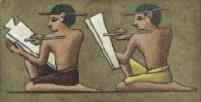AscendingPassage.com
See the: Egyptian Secrets Library.


Seboua by Hector Horeau 1841.
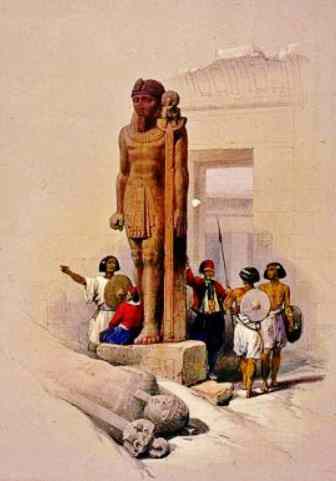
el Seboua Temple
The temple at El Seboua (Sabua or Saboua) in Egyptian Nubia was built on order of Pharaoh Ramesses II to honor two gods: Amon Ra and Ra Harmakis (Re-Horakhty, the Elder Horus). Seboua means the Lion's Wady, so-called from the two lines of sphinxes with the bodies of lions, which stand before the Rameses temple.
The Seboua Temple was relocated to avoid the rising waters from the Aswan high dam and now is a favorite with tourists. There was a second temple at Seboua, an older building built during the reign of New Kingdom Pharaoh Amenophis III and dedicated to the Nubian Horus and later to Amun. The Amenophis temple was not rescued and now is at the bottom of Lake Nasser.

Entrance to the Temple at Seboua,
by David Roberts, 1838

El Seboua Lion Temple
Edited excerpt from: Travels in Nubia
by John Lewis Burckhardt
Published in 1819.
There is a short route over the mountain from
Derr to Aswan, but I preferred following the banks of the river.
In ten hours, we reached opposite
Seboua (El Sebua, Saboua), where are fine ruins. They stand on the side of low
hills, which a narrow plain separates from the river.
In front of the Temple entrance, and about
thirty yards distant from it, are two statues ten feet in height, and seven paces from each other. Their faces
are towards the river, and they are attached by the back to a stone
pillar of equal height. They are rudely executed,
they both wear the high bonnet and represent unbearded male
figures. An avenue of sphinxes leads from the river to the temple,
but the greater part of them are now buried. Four remain by the
side of the two statues, differing from each other
in size and shape, but all representing the bodies of lions with
the heads of young men.
I observed a hole on the top of their flattened heads, intended to receive a small statue, or perhaps a lanp.


Wall art from the Temple at Seboua,
by François Chrétien Gau, 1819
In front of
the temple is a propylon (entrance pylon) similar to that of the temple of Gorne at
Thebes. It is twenty-eight paces in length, and in the center of
its two pyramidal wings is a small gateway, leading into the court
of the pronaos. It would seem the hillside had reclaimed the court, two-thirds of it is buried in sand. The pronaos
has five columns on each of its longest sides. In front of each column, and joined to it, is a colossal figure
like those at Gerf Hussain, about sixteen feet in height. The
arms cross upon the chest of each statue, with the flail in one hand and the
crosier in the other. All these figures are much mutilated.
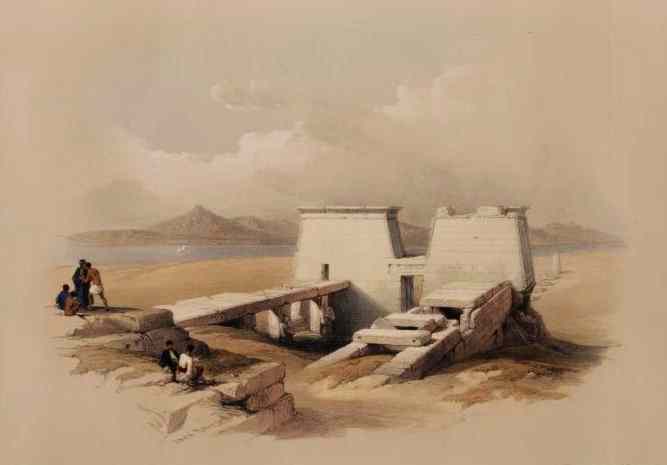
The Temple of Seboua,
by David Roberts, 1838
The
walls of the propylon and of the pronaos were constructed
of small blocks of very friable sandstone. They are so much decayed
that little now remains of the sculptures with which they were
originally covered. In front of the
entrance there lies on the ground a colossal human statue, much of it is buried in the sand. It probably stood
on the side of the gate, like the colossi at Luxor. It is a male
figure, and in the same attitude as the standing statues in front of the
temple at Abu Simbel.
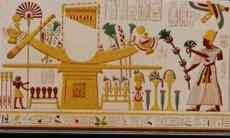
Pharaoh offering papyrus blossoms
to a boat shaped ark with a god inside,
by François Chrétien Gau, 1819
The whole fabric appears to be of
the remotest antiquity, and to have been imitated by the more
modern architects of Egypt. As
it was long after sunset before I quitted this temple, we proceeded
only half an hour farther, and nighted at the hut of an Aleykat (tribe) Arab.
NEXT CHAPTER
Edited excerpt from: Travels in Nubia
by John Lewis Burckhardt
Published in 1819.
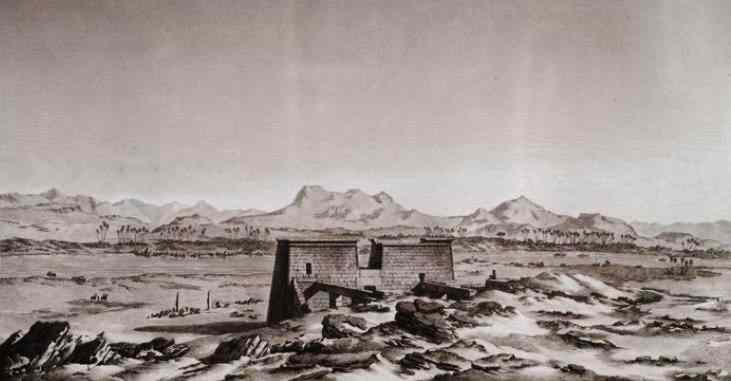
The Temple of Seboua,
by Francois Gau, 1822.

Floorplan of the Temple of Seboua,
by Francois Gau, 1822.

Caravan at Seboua,
by Samuel Manning, 1875.
Statue drawings by Francois Gau, 1822.

Countless beautiful 19th century images of ancient Egypt
and 75 pages of architecture, art and mystery
are linked from the library page:

The Egyptian Secrets Library
